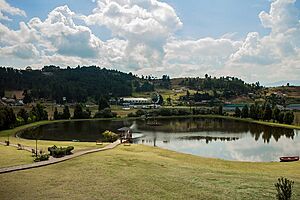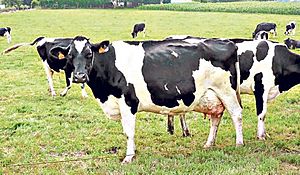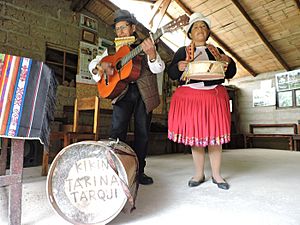Tarqui, Cuenca Canton facts for kids
Tarqui is a rural area, also called a parish, located in Cuenca Canton, Azuay, Ecuador. Cuenca is a big city and the capital of the Azuay province in southern Ecuador. It has many urban (city) and rural (countryside) parishes, and Tarqui is one of them. Tarqui is made up of 26 different communities.
Some of these communities are Atucloma, Santa Lucrecia, Tañiloma, Acchayacu, Bellavista, Las Américas - Estación, Gullanzhapa, Morascalle, Tutupali Chico, Tutupali Grande, Manzanapamba, El Verde, Chaullayacu, Santa Rosa, Chilcatotora, Parcoloma, San Pedro de Yunga, Chilcachapar, Cotapamba, Francesurco, San Francisco de Totorillas, Rosa de Oro, Santa Teresa, and Gulagpugro.
| Communities of Tarqui Parish | ||
|---|---|---|
| Acchayacu | Cumbe Station | San Pedro de Yunga |
| Atucloma | Frances Urco | Saint Lucretia |
| Bellavista | Gulagpugro | Santa Rosa |
| Parish Center | Gullanzhapa | Saint Therese |
| Chaullayacu | Manzanapamba | Tañiloma |
| Chilca Totora | Morascalle | Tutupali Chico |
| Chilcachapar | Parcoloma | Large Tutupali |
| Cotapamba | Rose Gold | Zhucay |
| The Green | San Francisco de Totorillas | |
Contents
Quick Facts About Tarqui
Tarqui is located at 3°00′49″S 79°02′04″W. Its official language is Spanish. It is part of the Azuay Province and the Cuenca Canton. The current President of the Parish Government is Galo Zhagüi. Tarqui was officially recognized as a parish on October 18, 1915, making it 108 years old. It covers an area of 135 square kilometers (about 52 square miles). The average height above sea level is 2,628 meters (8,622 feet). The climate is mild, with average temperatures from 12 °C to 20 °C (54 °F to 68 °F). The Tarqui River flows through the area. In 2010, the population was 12,490 people.
Tarqui's Past
Tarqui has a very long history! It goes back to the time of the Cañari people, then the Incas, and later the Spanish colonial period.
Early Settlements
Long ago, the Tarqui area was home to the Great Cañari Confederation. We know this because archaeologists have found old pottery there. Later, the Incas also settled in this area. It was an important stop on the famous Inca Trail.
During the time of the Spanish colonies, people in Cuenca needed more land for farming and raising animals. So, they started moving to open areas near the city, which included the Tarqui Valley.
What Does "Tarqui" Mean?
The name "Tarqui" comes from an old word. Some experts say it's from the Kichwa language and means "step." Others believe it comes from a Cañari word for a wind musical instrument called "Tarquies." A writer from Cuenca, Octavio Cordero Palacios, even wrote that the Inca leader Atahualpa played this instrument during battles with the Spanish.
Important Events
Tarqui has been part of two big moments in Ecuador's history:
- Measuring the Earth: The French Geodetic Mission came to Ecuador to check if the Earth was perfectly round. They used the Tarqui area as a key spot for their measurements.
- The Battle of Tarqui: This was an important battle where Ecuadorian forces stopped Peruvian soldiers from invading the city of Cuenca.
Becoming a Parish
In 1915, the local people asked for Tarqui to be officially recognized as a parish. The Cuenca City Council agreed. So, on October 18, 1915, Tarqui officially became a new parish. It covered 135 square kilometers and included 26 communities.
Today, Tarqui is a modern place with good services and beautiful nature. It's known for its peace and quiet.
Where is Tarqui?
Tarqui is a rural parish located southwest of the Cuenca canton. It has 26 communities. A main road, called Cuenca-Girón-Pasaje, connects Tarqui to Cuenca and other southern areas. The parish covers an area of 135 square kilometers.
Tarqui shares its borders with other parishes in the Cuenca Canton:
- To the north: Baños, Turi, and El Valle Parishes.
- To the south: Victoria del Portete and Cumbe Parishes.
- To the east: Quingeo and Santa Ana Parishes.
- To the west: Baños and Victoria del Portete Parishes.
People of Tarqui
According to a 2010 census, Tarqui parish has 10,490 people living in its 26 communities. Out of these, 4,833 (44%) are men and 5,657 (46%) are women. There are more women because many men have moved to other countries for work. The money they send back helps build many of the large buildings you see in Tarqui.
Most of the people in Tarqui are young, between 15 and 35 years old. These are the people who work and help the parish grow. Both men and women from Tarqui also migrate for work, sending money back home.
Here's how the people are spread out in the different communities:
| Community | Men | Women | Total | % Population |
|---|---|---|---|---|
| Acchayacu | 141 | 167 | 308 | 3.07% |
| Atucloma | 94 | 119 | 213 | 2.12% |
| Bellavista | 135 | 178 | 313 | 3.12% |
| Parish Center | 339 | 388 | 727 | 7.24% |
| Chaullayacu | 183 | 217 | 400 | 3.98% |
| Chilca Totora | 112 | 126 | 238 | 2.37% |
| Chilcachapar | 92 | 106 | 198 | 1.97% |
| Cotapamba | 189 | 205 | 394 | 3.92% |
| The Green | 111 | 140 | 251 | 2.50% |
| Frances Urco | 71 | 84 | 155 | 1.54% |
| Gulagpugro | 39 | 51 | 90 | 0.90% |
| Gullanzhapa | 466 | 578 | 1044 | 10.40% |
| The Americas | 130 | 147 | 277 | 2.76% |
| Manzanapamba | 46 | 57 | 103 | 1.03% |
| Morascalle | 127 | 149 | 276 | 2.75% |
| Parcoloma | 132 | 139 | 271 | 2.70% |
| Rose Gold | 67 | 88 | 155 | 1.54% |
| San Francisco deTotorillas | 67 | 75 | 142 | 1.41% |
| San Pedro de Yunga | 71 | 84 | 155 | 1.54% |
| Saint Lucretia | 99 | 107 | 206 | 2.05% |
| Santa Rosa | 104 | 116 | 220 | 2.19% |
| Saint Therese | 141 | 182 | 323 | 3.22% |
| Tañiloma | 155 | 185 | 340 | 3.39% |
| Tutupali Chico | 544 | 686 | 1230 | 12.25% |
| Large Tutupali | 539 | 574 | 1113 | 11.09% |
| Zhucay | 404 | 493 | 897 | 8.94% |
How Tarqui Makes Money
Tarqui's economy mainly relies on farming because it has lots of good land. After farming, raising animals (livestock), mining, and small industries are important.
Farming
The most common crop in Tarqui is corn, which is grown every year. Beans are often planted with corn. Other important crops include broad beans, peas, potatoes, and cabbages. Some communities also grow vegetables, barley, apples, and geese. Most of what is grown (95%) is used by families for food or for seeds. Only a small part (5%) is sold.
Raising Animals
People in Tarqui raise cattle, pigs, sheep, guinea pigs, and birds. Raising cattle is very important because it provides milk and meat to sell. Pigs are also raised for their meat, which is used in many local dishes. Guinea pigs and sheep are also common, and birds are raised in smaller numbers.
Small farmers usually raise animals using traditional methods. Larger farms, however, use newer technology for growing grass and taking care of their animals. This means they can produce more milk. A small farm might get 4 to 6 liters of milk per cow, while a modern large farm can get 15 to 20 liters per cow each day!
Mining
There are 9 active mining areas in Tarqui. These include places like San Pablo II, Condor Loma de Tarqui, and San Pedro de Yunga.
Small Industries
Tarqui has many small businesses and workshops. These include making things from wood, concrete items, shoes, and curtains. They also produce animal food and dairy products. There are about 14 factories that make pants and other clothes, some craft shops, and even an embroidery workshop.
Local groups, with help from the Parish Government, have also started making things like shampoo and soap from medicinal plants, pickled foods, grape and blackberry wines, and candles. These are small-scale productions, but people hope to improve them with better materials and technology.
Tarqui's Weather
Tarqui's weather is shaped by its mountains and other natural features. The average yearly temperatures are between 12 °C and 20 °C (54 °F to 68 °F). It rains about 500 to 2000 millimeters (20 to 79 inches) each year, mostly from October to November and February to May. Because of its high altitude (2600 to 3800 meters above sea level), Tarqui generally has a cool climate.
Plants and Animals
Plant Life
Tarqui has three main types of plant areas: Montane, high montane, and paramo. Each area has different kinds of plants. You can find natural plants like lichens, straw, mosses, chilcas, elderberry trees, walnut trees, and pencos. There are also many beautiful flowers like roses and carnations, and large areas of grasslands.
Twelve plant species found in Tarqui are unique to Ecuador. One species, Monactis holwayae, is considered endangered, but many of these plants can still be seen in Tarqui near forests and rivers.
Most of Tarqui (51.65%) is covered by Montane vegetation, found in the central part of the parish. High Montane vegetation (41.95%) is mostly in the eastern area. Finally, the moors are located in the western part of the parish.
Forests
About 26.32% of Tarqui is protected forest. This means that communities living in these areas must use the natural resources carefully and sustainably.
Animal Life
Tarqui has many different animals, both wild and domestic. Wild animals include rabbits, deer, and foxes. Domestic animals that people raise or keep are cattle, sheep, pigs, dogs, cats, horses, chickens, and guinea pigs.
Learning in Tarqui
Education is a right for everyone, no matter their age or background. The government helps make sure everyone can go to school, but families and the community also play a part. Education should be available to all, from early childhood through high school, without any unfair treatment.
In Tarqui, 8,264 people (about 87.81% of the population) know how to read and write. About 12.19% do not, and this group includes more women. Also, 3.85% of the people in Tarqui have gone to university.
Fun Things to Do in Tarqui
Yurak Allpa Zoo
The Yurak Allpa Zoo is about 14 kilometers (9 miles) from Cuenca. It was created by Mr. Alberto Vele, who wanted to build a safe place for wild animals. The zoo rescues animals that have been abandoned or taken from their natural homes. It has about 40 different types of animals and 200 animals in total! You can see tapirs, ocelots, deer, and many kinds of birds like eagles and parrots. There are also monkeys, squirrels, turkeys, and toucans.
The Yurak Allpa Zoo is open every day.
- Monday to Friday: 9:00 AM - 6:00 PM (by reservation).
- Saturdays and Sundays: 8:00 AM - 6:00 PM (open to everyone).
Frances Urco Hill
Frances Urco Hill is a pyramid-shaped mountain. It got its name, "French-Urco," because French scientists used it to measure the Earth's shape long ago. On this hill, there are old ruins of a shrine dedicated to the Cañari moon goddess.
The hill is located about 12 kilometers (7.5 miles) along the Panamericana Sur road in Tarqui. From the top, you can see amazing views of the Tarqui valleys. To reach the top, you need to climb 640 wooden and cement steps. The hill is 2,800 meters (9,186 feet) above sea level. Around the hill, you'll find delicate native flowers and tall pine trees.
Kushi Wayra Tourism Center
The Kushi Wayra Community Tourism Association is part of the Jambi Runa Health Foundation. This tourism center is run by the communities of Parcoloma and Chilca Totora. Its goal is to help visitors connect with the Andean Culture. You can take a tour to see the beautiful Andean landscapes and learn about medicinal plants.
At Kushi Wayra, you can learn about the Kichwa-Kañari culture. They show traditional farming methods, how to prepare food, make cheese, use medicinal plants, and even make clothes from sheep wool. You can also enjoy their music and dances.
Visitors can join in daily activities with local families, like farming, shearing sheep, spinning wool, and preparing traditional foods and drinks. You can also visit the "Nukanchik Kawsay" cheese factory to see how cheese is made and enjoy a traditional lunch called "pampamesa."
Taita Carnival
In the Andean culture, Taita Carnival (Father Carnival) is a special figure who represents lots of food and good fortune. Families welcome him with big meals and a traditional drink called "chicha de jora." People believe that a week before Carnival, this character comes out of the mountains to celebrate the time of good harvests.
In Tarqui, Carnival is a big celebration with traditional games, contests, and delicious food. Taita Carnival visits different communities to bless their farm products. The celebration usually starts with a parade where all the communities join in. Then there are activities like special masses, parades, a festival of "Mote Pata" (a traditional soup) and sweets, and contests for guinea pigs. There's also a game where a rooster is buried with its head showing, and people try to put a ring on it. The person who succeeds wins the rooster! The celebration ends with many artistic performances.
See also
 In Spanish: Tarqui (parroquia de Cuenca) para niños
In Spanish: Tarqui (parroquia de Cuenca) para niños





